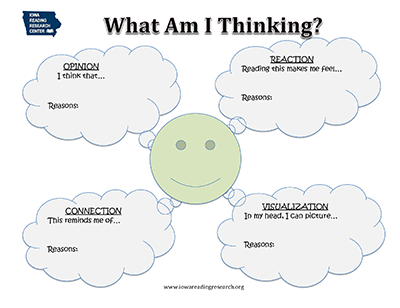508 words | 3 minute read
We recently shared a blog post about learning to ask questions while reading. Asking questions is a great strategy for readers to use before, during, and after reading to help monitor their comprehension. Other ways to help young readers organize their thoughts are included on the What Am I Thinking? organizer, which includes four different reading strategies to apply during reading: forming opinion, describing reactions, making connections, and visualizing.
I recently used the What Am I Thinking? organizer with my own children. I explained that our goal in using the organizer was to check our understanding while we read. At first, they needed guidance in using the four reading strategies highlighted on the organizer, but as we read more and more, they started using the strategies with less prompting.
Below are the four strategies highlighted on the What Am I Thinking? graphic organizer.
Opinions
Thoughtful readers take in new information from a book and combine it with their own knowledge to form an opinion or a judgment.
In this example, I asked a specific question to get my children thinking:
Me: What do you think about Ralph’s decision to go against Keith’s wishes?
Ryan: I don’t think Ralph should’ve ridden the motorcycle.
Me: Why do you think that? Give me a reason.
Ryan: If he had stayed in the mouse hole, he wouldn’t have gotten stuck in the laundry bag.
Reactions
Similar to how opinions are formed, new information from a book can make a reader feel a particular way (e.g. happy, scared, disappointed).
Example:
Me: How do you feel after we finished this chapter?
Griffin: Sad.
Me: Tell me why.
Griffin: Because Keith is upset with Ralph, and it said Ralph feels really upset.
Me: Great, can you jot that down?
Connections
Readers relate their own knowledge or experiences with information from the book to gain a better understanding.
Example:
Me: Does this book remind you of anything?
Ryan: When Sarah broke my dollhouse window.
Me: How does this remind you of that?
Ryan: Ralph lost Keith’s motorcycle and Keith was disappointed, just like I was really sad when she accidentally broke my dollhouse.
Visualization
Readers use the book to help create mental images of what they are reading about.
Example:
Me: What can you picture in your mind?
Griffin: The mouse riding the motorcycle down the hall and hiding from the dog that is barking.
Me: Why are you picturing that?
Griffin: The sleepy man is walking down the hall with the dog and the book says the dog sees Ralph and starts going crazy. I can picture the dog barking really loudly and Ralph sticking his tongue out at the dog (laughing).

The What Am I Thinking? graphic organizer helped guide discussion with my children and explore their thoughts about the book. What I really liked about the organizer was that it required the reader to provide evidence from the book to support his thinking. This tool can be used at home or in the classroom for readers to record their thoughts during reading.
